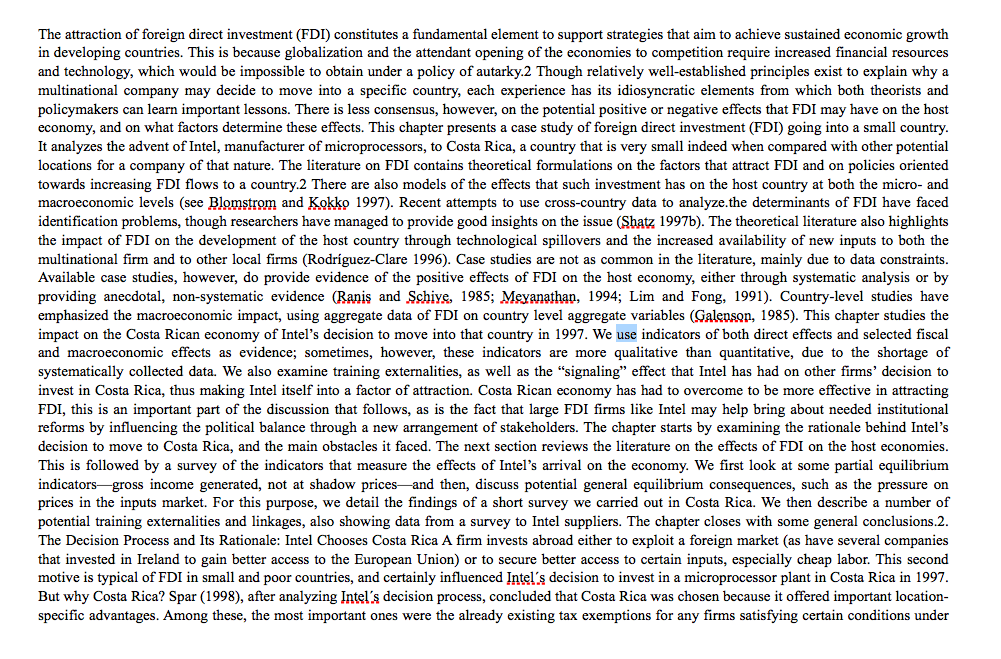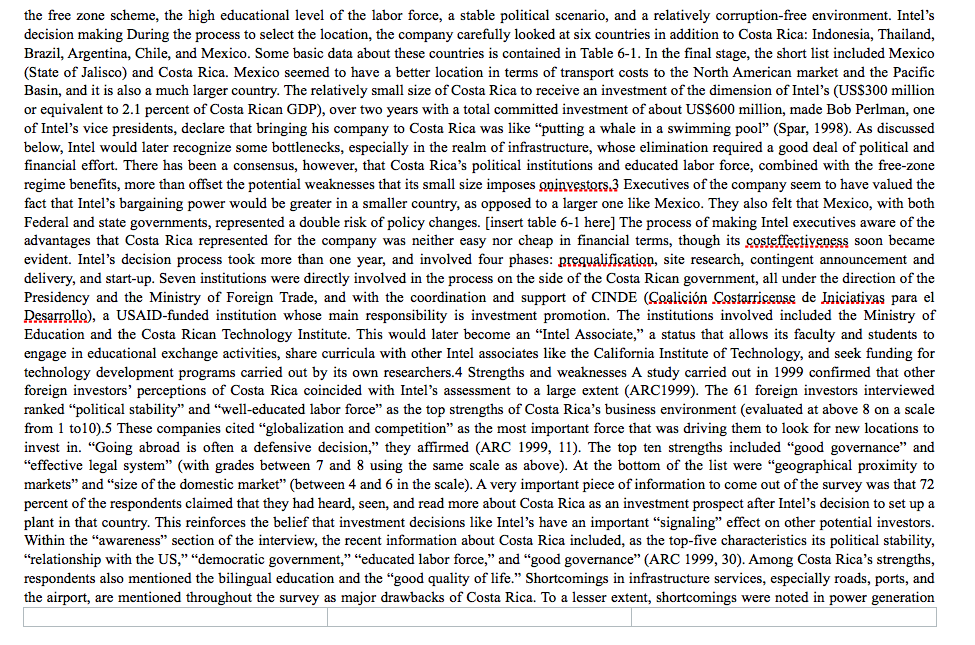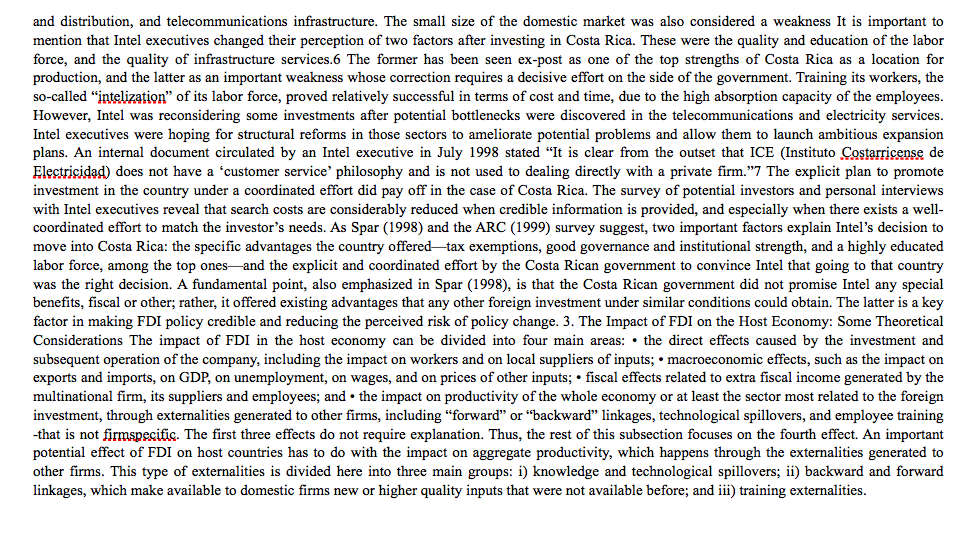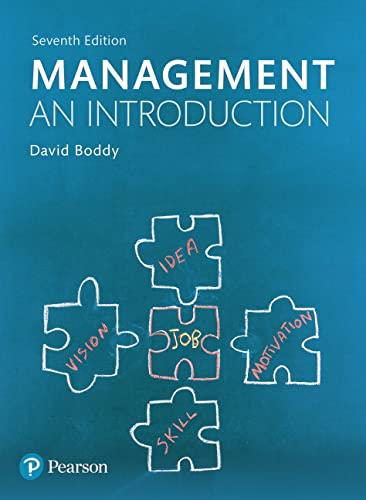The attraction of foreign direct investment (FBI) constitutes a fundamental element to support strategies that aim to achieve sustained economic growth in developing countries This is because globalization and the attendant opening of the economies to competition require increased nancial resources and technology, which would be impossible to obtain under a policy of autarky.2 Though relatively well-established principles exist to explain why a multinational company may decide to move into a specic country, each experience has its idiosyncratic elements from which both theorists and policymakers can learn important lessons. There is less consensus, however, on the potential positive or negative effects that FDI may have on the host economy, and on what factors determine these effects. This chapter presents a case study of foreign direct investment {FDI) going into a small country. It analyzes the advent ofInte], manufacturer of microprocessors, to Costa Rica, a country that is very small indeed when compared with other potential locations for a company of that nature. The literature on FDI contains theoretical formulations on the factors that attract FDI and on policies oriented towards increasing FDI ows to a country2 There are also models of the effects that such investment has on the host country at both the micro and macroeconomic levels (see )3th and Estate 1997). Recent attempts to use crosscountry data to analyzethe determinants of FDI have faced identication probln , though researchers have managed to provide good insights onthe issue (5m 1997b). The theoretical literature also highlights the impact of FDI on the development of the host country through technological spillovers and the increased availability of new inputs to both the multinational rm and to other local rms ("RodriguezClare 1996). Case studies are not as common in the literature, mainly due to data constraints. Available case studies, however, do provide evidence of the positive eiects of FDI on the host economy, either through systematic analysis or by providing anecdotal, nonsystematic evidence {Ennis and 5mg}, 1985; m, 1994; Lim and Pong, 1991]. Countrylevel studies have emphasized the macroeconomic impact, using aggregate data of FDI on country level aggregate variables (glepgop, 1985). This chapter studies the impact on the Costa Rican economy of Intel's decision to move into that country in 1997. We use indicators of both direct effects and selected scal and macroeconomic effects as evidence; sometimes, however, these indicators are more qualitative than quantitative, due to the shortage of systematically collected data. We also examine training externalities, as well as the \"signaling" e'ect that Intel has had on other rms' decision to invest in Costa Rica, thus making Intel itself into a factor of attraction. Costa Rican economy has had to overcome to be more eecve in attracting FD], this is an important part of the discussion that follows, as is the fact that large FDI rms like Intel may help bring about needed institutional reforms by inuencing the political balance through a new arrangement of stakeholders. The chapter starts by examining the rationale behind Intel's decision to move to Costa Rica, and the main obstacles it faced. The next section reviews the literature on the e'ects of FDI on the host economies. This is followed by a survey ofthe indicators that measure the eects of Intel's arrival on the economy. We first look at some partial equilibrium indicatorsgross income generated, not at shadow pricesand then, discuss potential general equilibrium consequences, such as the pressure on prices in the inputs market. For this purpose, we detail the ndings of a short survey we carried out in Costa Rica. We then describe a number of potential training externalities and linkages, also showing data from a survey to Intel suppliers. The chapter closes with some general conclusions2. The Decision Process and Its Rationale: Intel Chooses Costa Rica Arm invests abroad either to exploit a foreign market {as have several companies that invested in Ireland to gain better access to the European Union) or to secure better access to certain inputs, especially cheap labor. This second motive is typical of FDI in small and poor counties, and certainly influenced Intel's decision to invest in a microprocessor plant in Costa Rica in 1997. But why Costa Rica? Spar{1993), after analyzing Intel} decision process, concluded tbatCosta Rica was chosen because it offered important location specic advantages. Among these, the most important ones were the already existing tax exemptions for any rms satisfying certain conditions under the free zone scheme, the high educational level of the labor force, a stable political scenario, and a relatively corruption-free environment. Intel's decision making During the process to select the location, the company carefully looked at six countries in addition to Costa Rica: Indonesia, Thailand, Brazil, Argentina, Chile, and Mexico. Some basic data about these countries is contained in Table 6-1. In the final stage, the short list included Mexico (State of Jalisco) and Costa Rica. Mexico seemed to have a better location in terms of transport costs to the North American market and the Pacific Basin, and it is also a much larger country. The relatively small size of Costa Rica to receive an investment of the dimension of Intel's (US$300 million or equivalent to 2.1 percent of Costa Rican GDP), over two years with a total committed investment of about US$600 million, made Bob Perlman, one of Intel's vice presidents, declare that bringing his company to Costa Rica was like "putting a whale in a swimming pool" (Spar, 1998). As discussed below, Intel would later recognize some bottlenecks, especially in the realm of infrastructure, whose elimination required a good deal of political and financial effort. There has been a consensus, however, that Costa Rica's political institutions and educated labor force, combined with the free-zone regime benefits, more than offset the potential weaknesses that its small size imposes oninvestors.3 Executives of the company seem to have valued the fact that Intel's bargaining power would be greater in a smaller country, as opposed to a larger one like Mexico. They also felt that Mexico, with both Federal and state governments, represented a double risk of policy changes. [insert table 6-1 here] The process of making Intel executives aware of the advantages that Costa Rica represented for the company was neither easy nor cheap in financial terms, though its costeffectiveness soon became evident. Intel's decision process took more than one year, and involved four phases: prequalification, site research, contingent announcement and delivery, and start-up. Seven institutions were directly involved in the process on the side of the Costa Rican government, all under the direction of the Presidency and the Ministry of Foreign Trade, and with the coordination and support of CINDE (Coalicion Costarricense de Iniciativas para el Desarrollo), a USAID-funded institution whose main responsibility is investment promotion. The institutions involved included the Ministry of Education and the Costa Rican Technology Institute. This would later become an "Intel Associate," a status that allows its faculty and students to engage in educational exchange activities, share curricula with other Intel associates like the California Institute of Technology, and seek funding for technology development programs carried out by its own researchers.4 Strengths and weaknesses A study carried out in 1999 confirmed that other foreign investors' perceptions of Costa Rica coincided with Intel's assessment to a large extent (ARC1999). The 61 foreign investors interviewed ranked "political stability" and "well-educated labor force" as the top strengths of Costa Rica's business environment (evaluated at above 8 on a scale from 1 to10).5 These companies cited "globalization and competition" as the most important force that was driving them to look for new locations to invest in. "Going abroad is often a defensive decision," they affirmed (ARC 1999, 11). The top ten strengths included "good governance" and "effective legal system" (with grades between 7 and 8 using the same scale as above). At the bottom of the list were "geographical proximity to markets" and "size of the domestic market" (between 4 and 6 in the scale). A very important piece of information to come out of the survey was that 72 percent of the respondents claimed that they had heard, seen, and read more about Costa Rica as an investment prospect after Intel's decision to set up a plant in that country. This reinforces the belief that investment decisions like Intel's have an important "signaling" effect on other potential investors. Within the "awareness" section of the interview, the recent information about Costa Rica included, as the top-five characteristics its political stability, "relationship with the US," "democratic government," "educated labor force," and "good governance" (ARC 1999, 30). Among Costa Rica's strengths, respondents also mentioned the bilingual education and the "good quality of life." Shortcomings in infrastructure services, especially roads, ports, and the airport, are mentioned throughout the survey as major drawbacks of Costa Rica. To a lesser extent, shortcomings were noted in power generationand distribution, and telecommunications infrastructure. The small size oftbe domestic market was also considered a weakness It is important to mention that Intel executives changed their perception of two factors after investing in Costa Rica. These were the quality and education of the labor force, and the quality of in'astructure services.6 The former has been seen expost as one of the top strengths of Costa Rica as a location for production, and the latter as an important weakness whose correction requires a decisive effort on the side of the government. Training its workers, the so-called \"mum" of its labor force, proved relatively successful in terms of cost and time, due to the high absorption capacity of the employees. However, Intel was reconsidering some investments aer potential bottlenecks were discovered in the tel 'cations and electricity services. Intel executives were hoping for structural reforms in those sectors to ameliorate potential problems and allow them to launch ambitious expansion plans. An internal document circulated by an Intel executive in July 1998 stated \"It is clear from the outset that ICE (Instituto 5:95ng de lm does not have a 'customer service' philosophy and is not used to dealing directly with a private firm.\"'? The explicit plan to promote investment in the country under a coordinated effort did pay off in the case of Costa Rica. The survey of potential investors and personal interviews with Intel executives reveal that search costs are considerably reduced when credible information is provided, and especially when there exists a well coordinated effort to match the investor's needs. As Spar {1993) and theARC (1999) survey suggest, two important factors explain Intel's decision to move into Costa Rica: the specic advantages the country oiferedtax exemptions, good governance and institutional strength, and a highly educated labor force, among the top onesand the explicit and coordinated effort by the Costa Rican government to convince Intel that going to that country was the right decision. A fundamental point, also emphasized in Spar (1998), is that the Costa Rican government did not promise Intel any special benets, scal or other, rather, it offered existing advantages that any other foreign investment under similar conditions could obtain. The latter is a key factor in making FDI policy credible and reducing the perceived risk of policy change. 3. The Impact of FDI on the Host Economy: Some Theoretical Considerations The impact of FDI in the host economy can be divided into four main areas: - the direct effects caused by the investment and subsequent operation of the company, including the impact on workers and on local suppliers of inputs; - macroeconomic effects, such as the impact on alports and imports, on GDP, on unemployment, on wages, and on prices of other inputs; - fiscal e'ects related to extra scal income generated by the multinational firm, its suppliers and employees; and - the impact on productivity ofthe whole economy or at least the sector most related to the foreign investment, through externalities generated to other rms, including \"forward" or \"backward" linkages, technological spillovers, and employee training that is not 15mm. The rst three e'ects do not require explanation. Thus, the rest of this subsection focuses on the fourth effect. An important potential e'ect of FDI on host countries has to do with the impact on aggregate productivity, which happens through the externalities generated to other firms. This type of externalities is divided here into three main groups: i] knowledge and technological spillovers; ii] backward and forward linkages, which make available to domestic rms new or higher quality inputs that were not available before; and iii] training externalities









